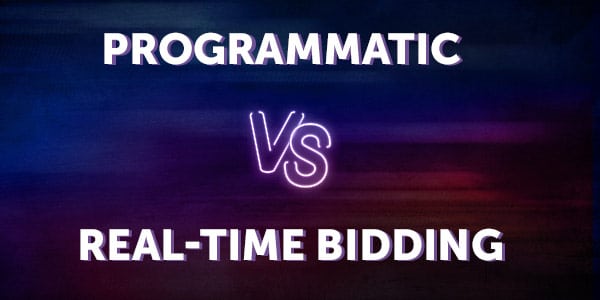RTB vs Programmatic Advertising, Marketing & Buying

Programmatic vs Non-Programmatic Advertising
Are you considering programmatic vs. RTB (real-time bidding) advertising techniques for your brand? Many marketers may be confused about the differences between programmatic vs. RTB. That’s understandable, as RTB is essentially a subset of programmatic advertising.
The two advertising methods are not the same thing, but you can’t have RTB without programmatic advertising, along with a supply-side platform (SSP) and a demand-side platform (DSP).
What is Programmatic Advertising?
Programmatic advertising uses software, or, in some cases, software-as-a-service (SaaS), to allow marketers to purchase digital advertising. More streamlined than traditional advertising methods, ads can be carefully targeted to the right audience and delivered in fractions of seconds.
According to research from eMarketer, programmatic advertising could represent 87% of all digital display ad spending by the end of 2021, up from 73% in 2016.
Programmatic advertising uses demand-side platforms (DSPs) and supply-side platforms (SSP) software to connect advertisers with ad inventory. It’s important to understand that the word “programmatic” in this context merely means that transactions take place computer-to-computer, rather than through manual processes requiring computer intervention.
Of course, the advertiser must set the parameters for ad placement, but from there, the SSP and DSP take over to match the supply with a specific demand. In regard to the lack of human intervention, social media advertising, email marketing and paid search are also “programmatic,” by definition, but it’s not what most marketers mean when they refer to programmatic advertising.
What is RTB or Real-Time Bidding?
Real-time bidding (RTB) is an automated process by which advertisers can place bids, in real time, for specific display ad placements. RTB is a programmatic process, but not all programmatic advertising takes place through RTB technology.
It’s important to understand that RTB is not the only way to buy programmatic advertising, although it is one of the most popular methods to purchase advertising because it allows advertisers to control costs while having a wide selection of advertising platforms across multiple channels. Viant, for example, offers access to omnichannel inventory sources while allowing marketers to by hyper-selective about their targeting variables. In addition to RTB, we provide access to hundreds of private marketplace (PMP deals) and programmatic guaranteed (PG) deals as well.
Programmatic vs. RTB: Similarities and Differences
Programmatic advertising encompasses multiple ways of placing ads. For instance, ads can be purchased through a private marketplace (PMP), where deals can be brokered through the DSP and structured based on advertiser objectives such as viewers or click-through rates. Some DSPs offer programmatic guaranteed (PG) deals, where publishers must promise a specific number of ad impressions, so that advertisers can be assured they’re getting their money’s worth from the placement.
RTB is yet another form of programmatic advertising, offering marketers access to omnichannel inventory sources and the capability to set their prices and targeting variables so the DSP can match them with the right ad at the right time.
Understanding the Benefits of RTB
RTB carries many benefits over traditional advertising, in that it’s automated and requires no human intervention on the supply-side. RTB offers transparency and scalability for advertisers, as well as advanced reporting so that advertisers can gauge the success of every campaign and continue to improve.
RTB permits advertisers to measure results across omnichannel marketing campaigns and then adjust ad spend or advertising parameters to improve results. The combination of broad reach and advanced targeting can lead to more successful campaigns. RTB allows marketers to target users based on a variety of factors, including past online behavior, demographics, geographical data, and even devices used.
Finally, RTB advertising enables marketers to retarget users with personalized messaging, which can improve click-through-rates, reduce the incidence of abandoned shopping carts and, ultimately, help increase revenue.
STAY IN THE LOOP WITH OUR NEWSLETTER
Sign up to get Viant news and announcements delivered straight to your inbox.
Sign up to get Viant news and announcements delivered straight to your inbox.
